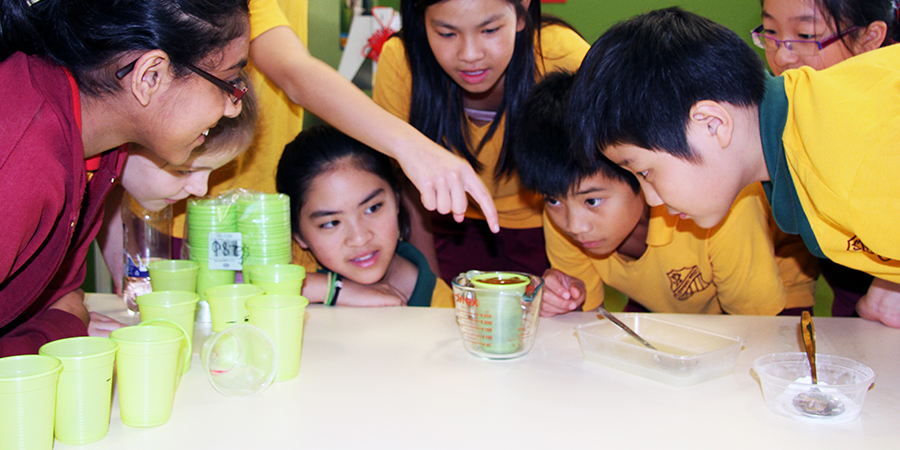MYSTIC STEP 2
STEP 1
Preparation for Mentoring
STEP 2
School Visit #1
STEP 3
School Visit #2
STEP 4
School Visit #3
STEP 5
Attend Science Fair

Goals for STEP 2
- Attend MySTic BRIEFING SESSION
- Attend SCHOOL VISIT #1 on the scheduled date and time
- Meet and greet ALLOCATED STUDENT GROUP/S
- Facilitate student group/s to select: FOCUS/TESTABLE QUESTION, VARIABLES, PREDICTION / HYPOTHESIS, METHOD and EQUIPMENT
Scroll down for more information.
STEP 1 – Plan Ahead
- BRIEFING SESSION: attend
- SCHOOL VISIT #1: attend correct location, on scheduled date and time
- STUDENT GROUP/S: get to know them
- INVESTIGATION PLAN: ensure student group/s have a ‘testable question’ and know what to do once you leave
STEP 2 is in Week 3 of School Implementation

STEP 1 – Information
Briefing Session
One of your School Science Teachers or one of the Primary School Teachers or a MyScience facilitator will hold a BRIEFING SESSION about what you will be doing as a Mentor.
Most of this information is covered in the website MySTic Implementation Steps but the session will provide you with:
- awareness of the physical layout of the primary school and classrooms (if held at the primary school),
- a chance to ask questions about the program, your role, the class theme, student needs etc.,
- an opportunity to meet teachers and other Mentors/MyStics who will be working with the primary students, which will promote a sense of belonging and focus around the purpose for coming into the school,
- awareness of the location of the School Office where you need to ‘sign in’ and ‘sign out’.
School Visit Information
- Check that you know the: NAME, TELEPHONE NUMBER, LOCATION and TRAVEL TIME to the primary school so that you arrive 10-15 minutes before your scheduled visit time. This may be organised for you by your Science Teacher.
- All schools require visitors to register their presence at the SCHOOL OFFICE, where you will be required to ‘sign in’ and to wear a ‘Visitor Badge’ while on the school premises during working hours.
- You will likely be met by senior primary students who will then take you to your contact teacher/classroom.
- Your school visit will be co-ordinated with other class Mentors/MySTics so that you are all in the class at the same time.
- At the conclusion of your school visit, return your badge to the School Office and ‘sign out’.
Student Groups
By the time of the first mentor visit your students should:
- each possess a LOGBOOK in which they have recorded their science activities, thoughts and ideas,
- have practised conducting ‘fair test’ scientific investigations related to the class theme with the support and guidance of their class teacher,
- understand that when conducting a fair test they need to use ‘Cows Moo Softly’ where COWS stands for CHANGE ONE THING, MOO stands for MEASURE SOMETHING and SOFTLY stands for KEEP EVERYTHING ELSE THE SAME,
- have participated in a class brainstorm around a THEME,
- have joined a student group who all agree to work on the same TOPIC, and generated a number of possible questions for their investigation – some of which may be ‘testable’.
Investigation Plan
Student groups need a clear plan for how to do their investigation.
By the end of Visit #1 each group should have recorded in their logbooks:
- a clear idea of their QUESTION,
- how they will CONTROL THE VARIABLES,
- a PREDICTION OR HYPOTHESIS,
- the METHOD OR STEPS that they will follow, and
- the EQUIPMENT that they will require.
Use the following RESOURCES for additional information about how to support your primary students in this phase of MyScience.
- Student Planned Investigations
- Testable Questions
- Predictions & Hypotheses
SCAFFOLDS/PROFORMAS that support student planning:
- Classroom Poster
- Student Scaffold #1 = BASIC
- Student Scaffold #2 = ADVANCED
REMEMBER:
- You are guiding and supporting the students – not telling them what to do.
- Challenge their questions and ideas, ask them for clarification such as:
‘What do you mean … ?’
‘What do you think will happen if …?’
‘If we change TWO things (e.g type of soil AND pot colour), how will we know …?’ - Your discussion and questioning is demonstrating what scientists do when they design a plan to answer their questions.
